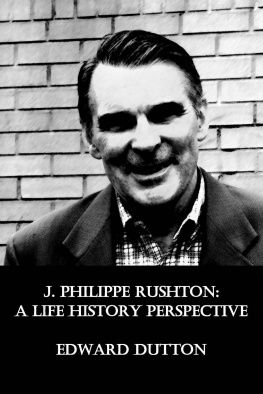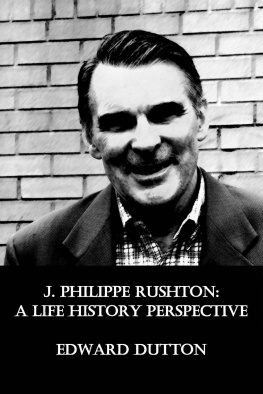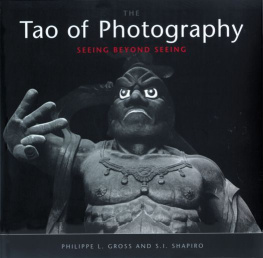J. Philippe Rushton - Controversy: Life as an Evolutionary Psychologist
Here you can read online J. Philippe Rushton - Controversy: Life as an Evolutionary Psychologist full text of the book (entire story) in english for free. Download pdf and epub, get meaning, cover and reviews about this ebook. year: 2012, publisher: unpublished, genre: Politics. Description of the work, (preface) as well as reviews are available. Best literature library LitArk.com created for fans of good reading and offers a wide selection of genres:
Romance novel
Science fiction
Adventure
Detective
Science
History
Home and family
Prose
Art
Politics
Computer
Non-fiction
Religion
Business
Children
Humor
Choose a favorite category and find really read worthwhile books. Enjoy immersion in the world of imagination, feel the emotions of the characters or learn something new for yourself, make an fascinating discovery.

- Book:Controversy: Life as an Evolutionary Psychologist
- Author:
- Publisher:unpublished
- Genre:
- Year:2012
- Rating:5 / 5
- Favourites:Add to favourites
- Your mark:
- 100
- 1
- 2
- 3
- 4
- 5
Controversy: Life as an Evolutionary Psychologist: summary, description and annotation
We offer to read an annotation, description, summary or preface (depends on what the author of the book "Controversy: Life as an Evolutionary Psychologist" wrote himself). If you haven't found the necessary information about the book — write in the comments, we will try to find it.
Controversy: Life as an Evolutionary Psychologist — read online for free the complete book (whole text) full work
Below is the text of the book, divided by pages. System saving the place of the last page read, allows you to conveniently read the book "Controversy: Life as an Evolutionary Psychologist" online for free, without having to search again every time where you left off. Put a bookmark, and you can go to the page where you finished reading at any time.
Font size:
Interval:
Bookmark:
Title Page
Controversy: Life as an Evolutionary Psychologist
Professor J. Philippe Rushton, Ph.D., D.Sc.
Department of Psychology,
University of Western Ontario,
London, Ontario, N6A 5C2, Canada
http://www.ssc.uwo.ca/psychology/faculty/rushton_bio.htm
Tel: 519-661-3685
The Human Genome Project
When the 13-year Human Genome Project was completed in 2003, mapping all 3.1 billion of the nucleotides or chemical base pairs that make up human DNA (and the estimated 30,000 to 40,000 genes in the human genome), one of its most publicly touted results was that it allegedly proved there was no genetic basis for race. The mapping indicated that people share 98.7 percent of their genes with chimpanzees and 99.9 percent with each other. The take home message portrayed by the media was one of harmonywe are the worldbarely a jot of genetic code separated male from female, Black from White, a mere tittle distinguished genius from retardation, or virtue from vice. A miniscule 0.1 percent spanned the gap from humanitys alpha to its omega. Since we were all 99.9 percent genetically identical, race and sex were mainly social constructions.
Statements like those, however, are, for the most, politically driven. Since there are 3.1 billion base pair building blocks in both the human and chimp genome, the 1.3 percent difference between them translates into about 40 million base pairs. Forty million changes to the human genome in the 5 to 8 million years since chimps and people parted company means there has been an evolutionary event every month or two all the way down to historic times. In the 60,000 years or so in which modern humans have been scattered in groups that have occupied widely different environmental niches and havent mixed much with each other, there have been another half-a-million changes in the building blocks. Thats why your average Eskimo doesnt look much like your average Australian aboriginal, to the point that five-year olds have no trouble distinguishing them, which makes things awkward for the Egalitarian Dogma.
Was the claim of the Human Genome Project that people are 99.9 percent identical to chimpanzees then made out of whole cloth? Not really. The statement was the truth, but it was not the whole truth and nothing but the truth. The potential perjury arises because different genetic measures are available for different purposes. On their most distinctive genes, for example, people share only 50% with each of their parents, very much less than they share with chimpanzees on the nucleotide measure. The much proclaimed similarities in base pair sequences all code for the same internal organs, eyes, hands, and so on in all groups of mammals. People are also 90% similar to mice on these sequences and so we can use mice as laboratory animals. Yet mice do not lookor actlike 90% humans. People actually share 40% of their nucleotide sequences with vegetables. Yet, even the most handicapped and impaired human being is not a turnip. People share identical atoms and molecules not only with all the animals and plants, but also with the mountains and oceans. The true take home message is what a difference a gene makes!
A massive international effortthe Haplotype Projectis currently underway to catalog and compare the haplotypes (closely linked genetic markers present on one chromosome which tend to be inherited together) of the various peoples of the world. The future of medicine may depend on it. It will tell us why, on average, Blacks and South Asians suffer from high blood pressure more frequently than do others, why heart attacks hit Middle Eastern men an average of 10 years earlier than Europeans, and why the Chinese boast the trimmest waistlines in the world. In 2004 the U.S. Food and Drug Administration took the courageous step of approving the worlds first ethnic medication, a heart-failure preventive drug called BiDil developed specifically for African Americans. Developments such as these led Francis Collins, a former leader of the Human Genome Project, to recant (in the fall 2004 issue of Nature Genetics ) that his own well-intentioned statements about race had left the wrong impression, writing, It is not strictly true that race or ethnicity has no biological connection.
Geneticists identify the same races as have anthropologists traditionally by examining cranial and skeletal measurements. A study by Tang et al. (2005), for example, asked 3,636 individuals to donate a DNA sample and identify themselves as being White, East Asian, African-American, or Hispanic. They found that the self-identifications clustered almost perfectly according to the 326 DNA markers they measured. Only five individuals had DNA that matched an ethnic group different than the box they had checked to classify themselves. That is an error rate of only 0.14 percent.
Boass False Claim That Head Shape Changed Due to Living in America
The article of faith that race is a mere social construction and not a biological fact entered the litany of the academic Left in 1910. Franz Boas, professor of anthropology at Columbia University, delivered apparently stunning empirical evidence that the social environment exercised dominion over human heredity. He claimed to have demonstrated that the human bodyparticularly the shape of the skullchanged in response to changes in the environment, thereby directly attacking one of the most widely accepted measures of the day, the cephalic index. The cephalic index is defined as the ratio of head length to head width (multiplied by 100 for convenience) and at the time was used to distinguish between the various European sub-races, such as the dolicocephalic (long-headed) Nordics and Mediterraneans on the one hand, and the brachycephalic (broad-headed) Alpines on the other.
Boass report, Changes in the Bodily Form of Descendants of Immigrants was part of a massive study on the effects of immigration, authorized and financed by the federal government. Boas (1910, 1912, 1940) claimed his data showed that the cephalic index changed as a direct function of how long immigrant children had lived in the United States. He further claimed that this cranial plasticity was a response to the new American, melting pot environment and concluded that race was a far more fluid concept than had previously been believed. Despite criticisms from the leading anthropologists of the time, Boass study became one of the tenets of the Egalitarian Dogma and is still widely accepted and cited frequently in papers dealing with race, human evolution, and social anthropology.
In the 2002 Proceedings of the National Academy of Sciences , anthropologists Sparks and Jantz re-examined Boass anthropometric data and found they had been inaccurately interpreted. They applied modern statistical techniques to over 8,000 individuals from the Boas data on Bohemians (immigrants from todays Czech Republic), Italians, Hebrews, Poles, Hungarians, Scots, and Sicilians, they found a relatively high genetic contribution (50%) across the generations for the head and face diameters, no effect of exposure to the American environment on the cranial index, and a small increase in the cranial vault among the Hebrew children. They concluded the results contradicted Boass original findings, which should no longer be used to support arguments of plasticity in cranial morphology.
Sparks and Jantz concluded that, Reanalysis of Boass data not only fails to support his contention that cranial plasticity is a primary source of cranial variation but rather supports what morphologists have known for a long time: most of the variation is genetic variation (p. 14,637). (Casual observation of Americas major cities with their historic China Towns and Little Italys tell the layman the same story.) They also raised questions about whether Boass anti-racist motivation was a factor in the way he had presented the data to make his argument look as convincing as possible. For example, they noted the absence of the usual statistical fluency for which Boas was noted. However, they stopped short of calling him a fraud.
Next pageFont size:
Interval:
Bookmark:
Similar books «Controversy: Life as an Evolutionary Psychologist»
Look at similar books to Controversy: Life as an Evolutionary Psychologist. We have selected literature similar in name and meaning in the hope of providing readers with more options to find new, interesting, not yet read works.
Discussion, reviews of the book Controversy: Life as an Evolutionary Psychologist and just readers' own opinions. Leave your comments, write what you think about the work, its meaning or the main characters. Specify what exactly you liked and what you didn't like, and why you think so.












